Dive Brief:
-
Almost 11% of adults deal with food allergies and that number is likely to grow, according to a new study in JAMA Network Open. At least half developed one or more allergies in their adult years.
-
Some 19% of respondents believed they had food allergies, many of which were actually other issues. Only half of all food-allergic adults were diagnosed by a doctor.
-
The top food allergy in adults is shellfish — which nearly 3% have — followed by 1.9% with a dairy allergy and 1.8% with a peanut allergy. Out of adults with one allergy, 45% had multiple ones. The study was a population-based survey of 40,443 adults administered by the University of Chicago form Oct. 9, 2015 to Sept. 18, 2016.
Dive Insight:
The study is good news for the allergy-friendly foods market, which has experienced significant growth in recent years. But the most common allergies don’t necessarily overlap with the sectors with the highest growth in alternative products.
It’s not just the food-allergic consumer that wants to see “free-from” on a package. Whether they have allergies or not, consumers want foods that can sport this label, which can range from lactose-free to non-GMO. Many are willing to try a “free-from” product on speculation that it will improve some aspect of their lives, whether they have an allergy or not.
Food manufacturers big and small are already exploring how to best take advantage of the market opportunity. Gluten-free products led the way, and now consumers are continuing to demand more –– especially dairy-free products like alternative milks. Some research suggests growth in dairy-free milk could grow by 16.6% by 2024. That could have a ripple effect throughout the supply chain as food manufacturers switch out ingredients and explore allergen-free packaged foods.
Allergy-friendly food is becoming more mainstream as time goes on. Last year, Nestlé released three-ingredient Simple Delicious Morsels under its Toll House chocolate line. which are free from the eight major allergens — dairy, soy, peanut, tree nut, fish, shellfish, wheat and egg. Mondelez's Enjoy Life brand makes snacks and sweets that are free of 14 common allergens. That brand, acquired by the snacking behemoth in 2015, has moved from the sidelines into the mainstream at a rapid pace.
The demand for free-from foods has expanded into other categories. For example, some people with peanut allergies can have a serious reaction through making contact with items containing the allergen. Some schools have opted for nut-free zones, extending the market for allergen-free products well beyond those who may have a reaction.
The market for consumer products depends on manufacturers that create alternative ingredients, too. To replace the gluten in wheat flour, some manufacturers are experimenting with chickpea flour. Producers are exploring sunflower and canola-based alternatives to the emulsifier soy lecithin.
The increased demand for free-from items presents both a challenge and opportunity for food manufacturers. Consumers like to buy products they feel reflect their nutritional and health goals, but they still want items that taste authentic. Certain ingredients, like gluten or dairy, aren’t always easy to replace while maintaining flavor and texture. And being certified allergen-free can be a headache for producers. It requires more paperwork and tons of testing, both of which come with a price tag. Manufacturers have to prove that an item is “nut free” and guarantee it will remain so throughout the supply chain.
However, the new data could push food manufacturers to develop more nut- and dairy-free products. And as food allergies become more common, manufacturers will want to do more to serve that community.













